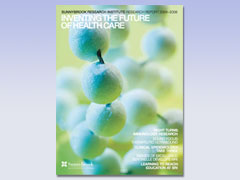The Colour of Flow
For the Nature Immunology paper on the role of Notch in sustaining T cell development, Maria Ciofani, though she could see the cells shrinking by comparing slides in the microscope, needed to quantify that change. She used SRI's state-of-the-art Centre for Cytometry and Scanning Microscopy to produce the requisite numbers on decreasing cell size and volume. The centre is essential to the work done at SRI by several molecular and cellular biologists. One important new piece of equipment it houses is the LSRII by BD Biosciences, funded primarily by the Canada Foundation for Innovation and Ontario Innovation Trust.
The LSRII is a $450,000 flow cytometer used to analyze and characterize cells and their environment after they've been sorted. It beams four independent laser lines onto cells suspended in liquid and stained with dyes to illuminate their various characteristics in up to 16 colours. A standard flow cytometer produces four colours with two lasers. Immunologists trying to characterize cell phenotypes, for example, use antibodies tagged with fluorescent dyes to look at proteins that are expressed by certain genes inside and outside the cells. Advances in this technology have dramatically increased the rate of scientific discovery: cell analyses that took 45 minutes 15 years ago now take less than 10 seconds and give much more detail.
Several functions of the LSRII, the most advanced analyzer on the market, couldn't have been performed at all—even two years ago. The multiple fluorescence protein array, which allows for analysis of multiple genes at once that have been tagged with different fluorescent dyes, is an example. Genes are introduced into cells, either transiently or permanently, and tagged with red, green or yellow dye. Gisele Knowles, who runs the flow facility, says, "From the 1990s until 2004, only one dye—green—could be used for that type of analysis. Now we can use three with the LSRII only. It means we can see the effects of three different genes in a cell at once. That's huge."
As biologists shift their focus from identifying the presence or absence of individual genes in disease to looking at how various genes interact at specific points in time—genomics—the LSRII is enabling SRI to stay at the forefront of genetics research.
Having the equipment is essential, but using it effectively can take cellular research to another level. Knowles, the first in Canada to get a sorter and with 22 years of experience to draw on, provides the direction to make that happen. "I'll probably never work with another flow technician of Gisele's calibre," says Renée de Pooter, a frequent user. "She understands the physics of the machines and the biology of the cells you're trying to sort, and that's extremely rare. She's amazing."
PDF / View full media release »


